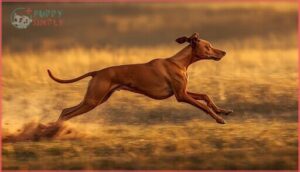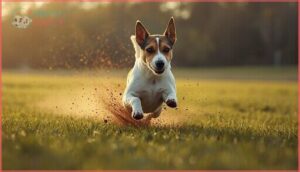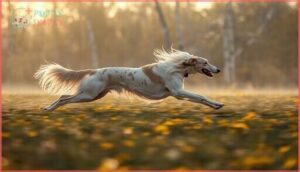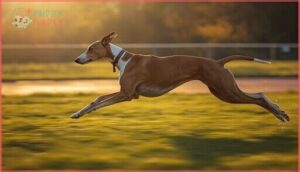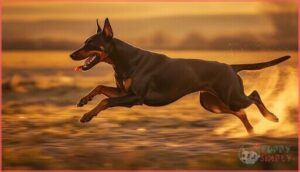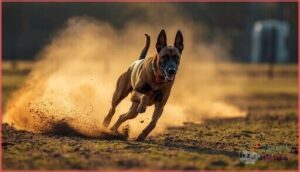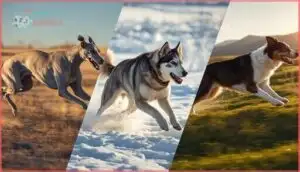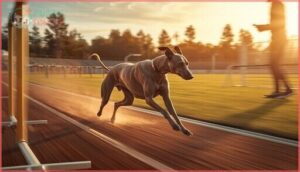This site is supported by our readers. We may earn a commission, at no cost to you, if you purchase through links.
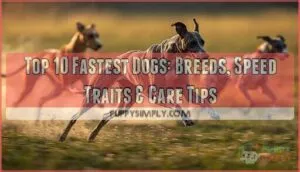 Wind whips past your ears as a streak of muscle and bone blurs across the grass—this is what raw speed looks like when you’re standing beside one of the fastest dogs on Earth. Watching a Greyhound stretch into a five-meter stride at nearly 45 mph, or a Saluki dance over the ground in easy pursuit, transforms the idea of canine athleticism into something almost mythic.
Wind whips past your ears as a streak of muscle and bone blurs across the grass—this is what raw speed looks like when you’re standing beside one of the fastest dogs on Earth. Watching a Greyhound stretch into a five-meter stride at nearly 45 mph, or a Saluki dance over the ground in easy pursuit, transforms the idea of canine athleticism into something almost mythic.
Yet, behind the record-breaking sprints and explosive launches lies a blueprint of anatomy, muscle, and instinct, tuned by nature and refined by breeders. If you’ve ever wondered how some dogs are born to fly, each detail matters more than you think.
Table Of Contents
Key Takeaways
- Greyhounds dominate as the fastest breed at 45 mph due to 70-80% fast-twitch muscle fibers, 6-7 meter stride length, and cardiovascular systems that reach top speed in just six strides.
- Speed depends on a combination of limb length (24% longer than average in fast breeds), muscle fiber composition, chest depth for lung capacity, and weight-to-power ratio rather than size alone.
- Fast breeds require 60-120 minutes of daily structured exercise including interval training, warm-ups, and cool-downs, plus mental stimulation through puzzle feeders and sports to prevent destructive behaviors and anxiety.
- Athletic dogs need specialized nutrition with sprint breeds requiring 40-50% carbohydrates and 22-28% protein, while joint protection through soft running surfaces, lean weight maintenance, and early supplementation prevents the injuries common in high-speed breeds.
What Makes a Dog Fast?
Speed isn’t just about long legs and a lean body, though those help. Your dog’s muscle fibers, chest depth, and even heart size play huge roles in how fast they can run.
Let’s break down the physical traits and instincts that turn certain breeds into four-legged rockets.
Key Physical Traits for Speed
Speed starts with your dog’s blueprint. The fastest dog breeds share limb length that’s 24% longer than average, paired with weight distribution that minimizes energy waste. Joint angulation affects power delivery, while cardiovascular capacity determines how long they can maintain that pace. Behind it all, muscle microstructure packed with fast-twitch fibers creates explosive acceleration. These aerodynamic bodies transform canine athleticism into pure velocity.
Greyhounds, for example, have a high percentage of fast-twitch muscle fibers which enable quick movements.
Muscle Composition and Stride Length
Fiber type ratios separate sprinters from joggers. Racing Greyhounds pack up to 70% fast-twitch muscle fibers in their limbs, compared to just 30-50% in non-sporting breeds. This muscle genetics advantage translates directly into dog speed. Genetic factors greatly influence a dog’s muscle composition.
Greyhound stride length averages 5.2 meters per stride, while smaller breeds compensate with higher frequency. Limb biomechanics and breed comparisons reveal that longer legs paired with elastic tendons create the explosive athleticism you see on the track.
Impact of Size and Build on Speed
Those muscle fibers need the right frame to shine. Ideal dog size matters—Greyhounds, weighing 60-70 pounds, hit 45 mph, while Jack Russell Terriers (13-17 pounds) reach 38 mph. Here’s what influences canine speed:
- Body shape influence: Dolichocephalic (long-headed) breeds outrun stocky, brachycephalic types
- Limb length effects: Long legs create longer strides and faster splits
- Chest depth impact: Deep chests boost lung capacity and cardiac output
Your dog’s weight-power ratio determines their ceiling for speed.
Prey Drive and Athletic Instincts
Physical build sets the stage, but prey drive brings it alive. This genetic predisposition—the urge to chase, stalk, and pursue—fuels your dog’s athletic instincts. Sighthounds like Greyhounds show this hunting behavior best, with genes like TRPM3 influencing both canine athleticism and dog speed.
| Breed Type | Prey Drive Intensity |
|---|---|
| Sighthounds | Very High |
| Terriers | High |
| Herding Breeds | Moderate-High |
| Companion Breeds | Low-Moderate |
Understanding breed differences helps with training implications and ethical considerations around exercise needs.
Top 10 Fastest Dog Breeds
Now that you understand what powers canine speed, let’s look at the breeds that put these traits into action.
The following rankings are based on documented top speeds, though individual dogs may vary slightly depending on conditioning and terrain.
Here are the ten fastest dog breeds you’ll find running circles around the competition.
Greyhound – 45 Mph
When you think of the fastest dog, you’re picturing a Greyhound. This sighthound blasts to 45 mph, making it the undisputed champion. Its racing heritage shaped notable traits:
- Muscle fibers contain 70-80% fast-twitch composition for explosive acceleration
- Stride length extends 6-7 meters per bound
- Top speed reached within just six strides
- Greyhound adoption offers retired racers loving homes
Their training needs remain surprisingly moderate indoors, though Greyhound health requires joint monitoring.
Saluki – 42 Mph
You’re looking at 42 mph in the Saluki, a sighthound bred for coursing abilities across desert terrain for thousands of years. Some reports push their top speed near 50 mph during pursuit.
Their breed history as Middle Eastern hunters shaped considerable endurance alongside acceleration. Saluki speed requires consistent exercise needs—daily runs prevent boredom.
Watch for health concerns like cardiac issues and hip dysplasia in this ancient fastest dog breed.
Afghan Hound – 40 Mph
Afghan hound top speed hits 40 mph, thanks to their aerodynamic build and coursing history chasing prey across Afghan mountains. Sighthounds like these need specific care:
- Exercise needs: Daily runs maintain muscle tone and mental health
- Grooming impact: Their long coat requires brushing to preserve speed efficiency
- Breed health: Watch for hip dysplasia and eye conditions
- Dog breed characteristics: Independent temperament affects training approaches
Vizsla – 40 Mph
Vizsla top speed reaches 40 mph, matching Afghan Hounds through their lean, muscular build and relentless prey drive. These fastest dog breeds excel in sustained running thanks to high red blood cell counts and cardiovascular efficiency.
Your Vizsla needs daily high-intensity exercise and agility activities to maintain peak performance. Vizsla training demands consistency, while Vizsla nutrition should prioritize protein-rich foods supporting their athletic metabolism and preventing joint issues common in high-energy dog breed characteristics.
Jack Russell Terrier – 38 Mph
Jack Russell Terriers can reach a top speed of 38 mph, demonstrating that their compact build does not hinder their running speed when combined with explosive fast-twitch muscle fibers and a relentless prey drive.
Your JRT’s terrier speed demands structured exercise routines to address their notorious training challenges. These high-energy dog breeds require JRT agility work and mental stimulation to channel their intensity effectively.
Proper JRT health management involves monitoring joint stress from their powerful acceleration and ensuring nutrition fuels their athletic metabolism.
Dalmatian – 37 Mph
Dalmatians clock a top speed of 37 mph, blending endurance training capacity with explosive acceleration. Their coach dog heritage required sustained stamina alongside spotted speed, making them uniquely adaptable among fast dog breeds.
Key Performance Factors:
- Lean muscle composition bolsters both sprinting bursts and extended running sessions
- Coat aerodynamics remain ideal despite their distinctive spotted pattern
- Dalmatian health management requires monitoring for joint stress during high-intensity dog exercise
Borzoi – 36 Mph
Originally bred as a Russian Wolfhound, the Borzoi reaches top speeds of 36 mph through a combination of long-legged grace and powerful hindquarters. You’ll notice their Borzoi sprinting technique relies on sighthound breed characteristics—lean muscle mass paired with remarkable Borzoi agility.
Among fastest dog breeds, their dog running speed reflects centuries of coursing selection, though Borzoi health monitoring remains important during high-intensity pursuits.
Whippet – 34 Mph
Often called a “miniature Greyhound,” the Whippet reaches a top speed of 34–35 mph, making it one of the fastest dog breeds relative to body size. This breed’s agility and acceleration shine in lure coursing and sprint races.
Its temperament favors gentle companionship indoors, but exercise needs remain high—daily runs prevent boredom-related behaviors.
Diet specifics should support lean muscle without excess weight, reducing common injuries like muscle strains.
Doberman Pinscher – 32 Mph
You’ll find the Doberman Pinscher among the fastest dog breeds, reaching speeds of 32–35 mph. This breed’s muscular build and lean physique evolved from its history as a protection dog, requiring both explosive speed and endurance.
Training needs emphasize consistent exercise to channel their high energy, while temperament traits balance alertness with loyalty.
Health concerns include hip dysplasia, so maintaining proper conditioning protects joints during high-speed pursuits.
Belgian Malinois – 33 Mph
Like the Doberman, the Belgian Malinois brings speed and purpose together, hitting 33 mph with striking agility. You’ll see this breed’s herding instincts and training intensity shine in military applications worldwide.
Their breed versatility makes them stand out among fastest dog breeds:
- Top speed sustained during extended pursuits
- Explosive acceleration for tactical work
- Quick directional changes showcasing Malinois agility
- High dog exercise needs requiring structured routines
Breed Profiles and Running Abilities
Not all fast dogs are built the same. Some rely on explosive sprints to chase down prey, while others use steady endurance for demanding work.
Let’s break down how different breed groups stack up in terms of speed and running style.
Sighthounds Vs. Working Breeds
You might think all fast dogs are built the same, but sighthounds and working breeds tell different stories. Let’s break down the speed vs. endurance trade-off that defines these fastest dog breeds.
| Feature | Sighthounds (Greyhounds) | Working Breeds (Malinois) |
|---|---|---|
| Top Speed | 45 mph burst sprints | 20-30 mph sustained |
| Muscle Fiber | 60-70% fast-twitch | 40-50% fast-twitch |
| Stride Length | 4.5-7 meters | Shorter, frequent strides |
| Primary Role | Hunting instincts for prey | Endurance tasks, herding |
Breed evolution shaped their gait analysis distinctly. Sighthounds excel in explosive chases, while working dog breeds maintain steady output. Dog breed comparisons reveal each type’s specialized athletic profile, making dog breed speed context-dependent.
Small Fast Breeds Vs. Large Fast Breeds
When comparing fastest dog breeds by size, you’ll notice striking differences in how speed translates across the spectrum. Large breeds like Greyhounds hit 45 mph with stride length exceeding 6 meters, while small sprinters such as the Italian greyhound max out at 28 mph.
The Whippet bridges this gap at 34 mph, proving aerodynamics and muscle fibers matter more than mass alone for dog breed speed.
Unique Speed Adaptations in Each Breed
Beyond raw top speed, each sighthound has evolved distinct racing tools. Greyhounds possess an aerodynamic body paired with double gallop mechanics and specialized foot structure—hinged ankles extend stride length dramatically. Their muscle fibers contain 70-80% fast-twitch composition, while oversized hearts and lung capacity fuel explosive acceleration.
Salukis trade sprint power for endurance with flexible spines, whereas Afghan Hounds balance agility against their protective coats on rough terrain.
Exercise and Training for Speedy Dogs
Owning a fast dog is like having a Ferrari in your garage—you can’t just let it idle. These breeds need structured exercise and smart training to channel their speed and energy productively.
Owning a fast dog means channeling their power with structured exercise and smart training, not letting their energy idle
Here’s how to keep your speedster healthy, happy, and well-behaved.
Essential Exercise Routines
Your fast dog needs 60–120 minutes of daily exercise, split into two sessions. Interval training—alternating 2-minute sprints with 1-minute recovery—builds cardiovascular stamina and speed capacity.
Cross-training with swimming or fetch games prevents overuse injuries while meeting intense exercise needs.
Always include 5-minute warm-ups and cool-downs for injury prevention, then schedule active recovery days to support your dog’s health and fitness.
Dog Sports and Agility Activities
Competitive dog sports transform raw speed into refined performance. Your athletic canine can channel energy into structured activities that deliver agility training impact alongside agility mental benefits:
- Agility courses: Dogs navigate obstacles at 4.9–6.3 yards per second while building neuromuscular coordination
- Flyball: Team-based racing that satisfies prey drive
- Lure coursing: Sighthounds hit 45 mph chasing mechanical lures
- Dock diving: Explosive jumps exceeding 30 feet
- Disc dog: Speed plus precision catching
Socialization and Mental Stimulation
Your speed-bred athlete needs mental conditioning as much as physical. Early socialization between weeks 1-6 lowers separation anxiety by 22% and builds confidence—puppy profiling scores jump from 3.1 to 3.8. Enrichment modalities like puzzle feeders cut destructive behaviors by 37% while enhancing cognitive benefits.
These interventions deliver stress reduction (31% fewer stereotypic behaviors) and strengthen behavioral health, with properly socialized dog breeds showing 42% fewer fear reactions.
| Enrichment Type | Behavioral Impact | Cognitive Benefit |
|---|---|---|
| Puzzle feeders | 37% ↓ destructive behaviors | 29% ↑ problem-solving |
| Olfactory challenges | 28% ↓ vocalization | 15% faster approach to novelty |
| Human interaction | 19% ↓ mood disorders | 27% ↑ relaxation markers |
| Tactile/visual stimuli | 20% ↑ novel environment response | 22% slower cognitive decline |
Regular mental stimulation through dog breed training and proper dog breed socialization prevents the anxiety that derails athletic temperament in fast breeds.
Training Tips for High-Energy Breeds
Consistent commands during training increase success rates by 40%, so pick your cues and stick with them. Short sessions of 10–15 minutes outperform marathon drills for retention.
Structured play before dog training sharpens focus, while exercise variety across multiple locations boosts adaptability by 25%.
For injury prevention in high-speed canine performance, avoid jumps until skeletal maturity—starting before 18 months raises injury risk to 41%.
Health and Care for Fast Dog Breeds
Owning a fast dog breed means you’re caring for a finely tuned athlete, and that comes with specific health considerations. From joint strain to nutritional demands, these speedsters need more than just regular vet visits to stay in peak condition.
Let’s look at the key areas where your attention will make the biggest difference in keeping your fast dog healthy and performing at their best.
Nutrition for Athletic Performance
When you’re fueling a high-performance athlete—whether sprinter or endurance runner—macronutrient ratios become your secret weapon. Sprint breeds thrive on 40–50% carbohydrate and 22–28% protein, while endurance dogs need over 50% of their calories from fat.
Here’s what your fast dog’s diet should include:
- Caloric Demands: 400–600 kcal per cup for active athletes
- Protein Needs: Minimum 75g per 1000 kcal prevents muscle loss
- Hydration Timing: Unlimited water access before, during, and after exercise
- Supplement Strategies: Omega-3s and leucine support recovery
Feed major meals four hours before exercise and within two hours post-workout for best canine health and performance.
Preventing Injuries and Joint Issues
Peak performance and dog health go hand-in-hand, but those lightning-fast strides come with real injury risks. You can protect your speedster’s joints through exercise modification—swap hard pavement for soft grass to minimize surface impact, and limit abrupt stops after sprints. Weight management matters more than you’d think; lean dogs sustain far fewer orthopedic injuries. Joint supplements introduced early help delay osteoarthritis, especially in athletic breeds prone to canine health issues.
| Risk Factor | Prevention Strategy |
|---|---|
| Hard surfaces | Use grass or dirt trails |
| High-impact jumps | Swimming and treadmill work |
| Excess weight | Maintain lean body condition |
| Repetitive strain | Twice-weekly passive stretching |
Grooming Needs of Fast Breeds
You’ll find that dog breed grooming varies wildly among fast dogs. Greyhounds and Whippets shed minimally—weekly brushing manages coat shedding, and bathing frequency stays low at every few months. Afghan Hounds demand daily attention for their silky coats.
Watch for skin sensitivity in sighthounds, and don’t skip nail trimming every 2–4 weeks or ear cleaning, since moisture breeds infection in folded ears.
Maintaining a Healthy Weight for Speed
Because every pound counts on the track, keeping your dog at its ideal BCS is key for performance impact and stamina. A lean frame lowers injury risks and boosts dog health and fitness, while carefully managed diet composition and scheduled meal feeding anchor weight protocols.
Combine these habits with specific dog breed exercise recommendations to improve health and speed.
Frequently Asked Questions (FAQs)
How is the top speed of a dog determined?
In determining a dog’s top speed, you’ll see speed measurement tools, gait analysis, and biomechanical analysis in action.
All shapes and sizes, environmental impact, genetic factors, and breed variations play critical roles.
How can I safely help my dog reach its top speed?
To help your dog reach its top speed safely, start with a proper warm-up, use safe surfaces, progress gradually, provide hydration, incorporate cool-down routines, and tailor exercise and training to your dog’s breed and behavior.
Can fast dogs live happily in apartments?
Space-savvy strategies suit sprightly pups: breed-specific suitability and indoor temperament matter most for apartment dogs.
Consistent apartment exercise routines plus outdoor access impact energy levels, keep high-energy breeds happy, and help manage dog breed exercise needs with success.
How do fast dogs behave with children?
Early socialization and consistent training techniques shape positive interactions between fast dog breeds and children. With clear safety guidelines and supervision, these family-friendly breeds display gentle temperaments and become reliable, well-behaved family pets.
Are fast breeds prone to anxiety or stress?
Picture a dog pacing when fireworks erupt outside—that’s anxiety in action. Genetic predispositions, environmental triggers, and a need for stimulation all play a role.
Behavioral signs often signal stress, making dog training and breed health essential for emotional balance.
What are the best toys for fast dogs?
Choose chase toys like flirt poles or ball launchers alongside puzzle feeders to engage your dog’s mind.
Opt for durable materials like reinforced nylon or natural rubber, ensuring training toys meet safety standards for agility and exercise.
How do you safely exercise a fast dog?
You need warm-up routines before intense exercise, injury prevention through proper surfaces, structured exercise regimens for endurance, athletic nutrition for recovery, and weight management strategies.
Monitor dog health while addressing your dog breed’s exercise needs during training.
Conclusion
The next time you watch one of the fastest dogs blur across a field, you’ll recognize the anatomical precision behind each stride—the sculpted muscle, the aerodynamic build, the instinct coded deep in their bones. Speed isn’t accidental; it’s engineered through generations of selection and care.
Whether you’re training a Greyhound or keeping a Vizsla fit, understanding what fuels their performance means you’re not just admiring velocity—you’re sustaining it.




